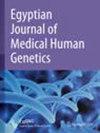VHL mutation as a cause of three generations familial pheochromocytoma
IF 1.2
Q4 GENETICS & HEREDITY
引用次数: 0
Abstract
Pheochromocytoma is a rare disease, and its familial occurrence is quite uncommon. The aim of this paper is to report a three-generation phenotypical expression of a case familial occurrence of pheochromocytoma. A 25-year-old female, with a history of adrenalectomy for pheochromocytoma, arrived at the shock room during her third pregnancy with an adrenergic crisis and hypoglycemia. To prevent perinatal complications, the patient was stabilized and the newborn was delivered through a Kerr-type cesarean section. A detailed history revealed that the paternal grandfather of the patient had an unilateral pheochromocytoma, whereas her paternal uncle had a bilateral pheochromocytoma. Additionally, a brother of the patient presented a unilateral pheochromocytoma. Amplicons for PCR assays were designed to span the protein-coding segments of the three Von Hippel–Lindau (VHL) exons, and the PCR products were sequenced using the Sanger method. In the trace of exon 3, we detected in the sample of the proband a heterozygous guanine to adenine transition (NM_000551.4 c. 552G > A) within the protein-coding segment of exon 3 of the VHL gene, which leads to a substitution of the arginine residue at position 161 by a glutamine residue in the encoded peptide (NP_000542.1p.R161Q). This mutation was absent in two unaffected daughters. A VHL mutation was suspected and confirmed in this family that was not transmitted to a fourth generation. This case illustrates the importance of molecular genetics methodologies to assist genetic counseling in cases of pheochromocytoma where familial aggregation is presumed.VHL 基因突变是三代家族性嗜铬细胞瘤的病因之一
嗜铬细胞瘤是一种罕见疾病,其家族性发生也相当罕见。本文旨在报告一例家族性嗜铬细胞瘤的三代表型表达。一名 25 岁的女性曾因嗜铬细胞瘤接受过肾上腺切除术,在第三次怀孕期间因肾上腺素能危象和低血糖症来到休克室。为防止围产期并发症,患者病情得到稳定,新生儿通过凯尔式剖腹产分娩。详细的病史显示,患者的祖父患有单侧嗜铬细胞瘤,而其叔父患有双侧嗜铬细胞瘤。此外,患者的兄弟也患有单侧嗜铬细胞瘤。用于 PCR 检测的扩增子被设计为跨越三个冯-希佩尔-林道(Von Hippel-Lindau,VHL)外显子的蛋白质编码片段,并使用 Sanger 方法对 PCR 产物进行了测序。在第 3 号外显子的痕量中,我们检测到疑似患者样本中的 VHL 基因第 3 号外显子蛋白编码段中存在鸟嘌呤到腺嘌呤的杂合转变(NM_000551.4 c. 552G > A),这导致编码肽(NP_000542.1p.R161Q)中第 161 位的精氨酸残基被谷氨酰胺残基取代。两个未受影响的女儿均未出现这种突变。在这个家族中,有人怀疑并证实存在 VHL 突变,但这种突变没有传给第四代。该病例说明了分子遗传学方法在推测家族聚集性嗜铬细胞瘤病例中协助遗传咨询的重要性。
本文章由计算机程序翻译,如有差异,请以英文原文为准。
求助全文
约1分钟内获得全文
求助全文
来源期刊

Egyptian Journal of Medical Human Genetics
Medicine-Genetics (clinical)
CiteScore
2.20
自引率
7.70%
发文量
150
审稿时长
18 weeks
 求助内容:
求助内容: 应助结果提醒方式:
应助结果提醒方式:


